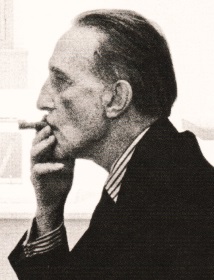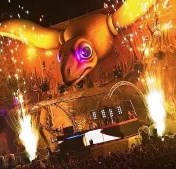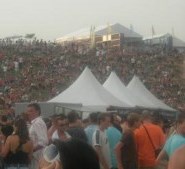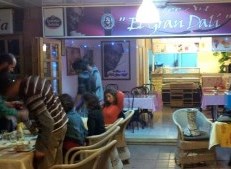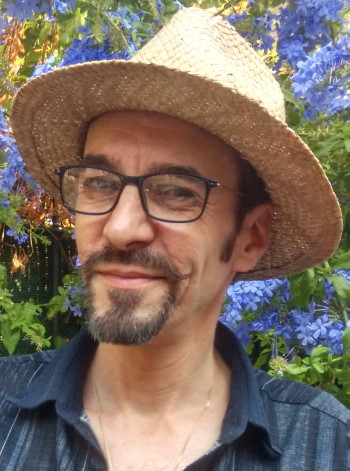
| Real Name | David De Jong |
|---|---|
| Birth | February 24, 1969 in Sofia (Bulgaria) |
| Nationality | Franco-Dutch |
| Profession | Pirate & protester visual artist |
Signature

David Duchamp, nicknamed « Duchamp The Young », is a Franco-Dutch visual artist.
His palette covers a wide variety of styles. As each of his creations is so different, it is difficult to identify him with a specific artistic trend.
He is primarily known for his tribute and protest artworks.
He is the inventor of the term and concept : « Ready-Remade ».
Memoirs
David Duchamp, whose real name David De Jong, was born in Sofia (Bulgaria) on February 24, 1969, to a Dutch father and to a Franco-Belgian mother.
In the '70s, his father was a commodity trader in Brussels (Belgium), while his mother, a secretary, worked with him.
They married a little after and his father decided to cross the Iron Curtain to go to Karlovo in Bulgaria, where he settled, building a business exporting roses from Damascus [1].
David spent the first five years of his life there, until his parents sent him to a primary boarding school in Switzerland, so that he could benefit from the best education possible.
Afterwards, he studied at the Tonelli College in Leytron (Switzerland) until baccalaureate level.
It was here that his art teacher would teach him drawing, painting, photography, craft and art history.
Meanwhile, his maternal grandparents settled on the French Riviera in Cannes (France) where he spent each of his summer holidays [2], as well as each Christmas with his parents.
A former teacher, his grandmother was passionate about art and his grandfather was an amateur figurative painter as well.
His grandparents often took him to exhibitions and openings, where he was exposed to artists who would become famous later : the sculptor César, Arman, Niki de Saint-Phalle, Jean Tinguely, Ben, etc...
In addition, his parents took him to the biggest museums in Europe during their holidays, which allowed him to admire and appreciate ancient art.
At the age of 18, David fell in love and chose to abandon everything, against the advice of his family, to live with his partner in Madrid (Spain).
This sentimental relationship would be brief because of his disgust with this country's barbarian traditions towards animals, which she defended with fervor.
For the next thirty years, he traveled all over Europe, living for a long time in each country, where he practiced different trades (salesman, waiter, handyman, singer, ...)
During this period, he exhibited and sold his artworks under various pseudonyms.
Ultimately however, he felt forced to adopt an artist's name, as he says in his interview :
Marcel Duchampin 2016, I lost all of my belongings during a move, then I had to recreate all my lost artworks.
Two years later, after a long period of depression, I finally got down to work.
I had previously signed my artworks under various pseudonyms derived from my name.
But in 2018, when I decided to dedicate the rest of my life to art, I started looking for a definitive pseudonym.
I consider that Marcel Duchamp was an excellent innovative painter and a great genius for artistic provocation.
André Breton called him « the most intelligent man of the century ».
And as I take over, in the manner of Brueghel :
- « Duchamp the Elder » brought art to the level of pure intellectualization.
- « Duchamp the Younger » now brings art back to the retinal level !
Let's not forget that the eyes are directly connected to the brain, so the psychic interpretation of the artwork happens in a second time, either subjectively, or with an explanatory text.
Despite this, one has only to see David Duchamp's creations, and note that all are different, innovative and the fruit of his own ideas and his own talent.
He says that he had to wait patiently for the time to come when people could finally understand his work, and that this change has finally begun.
Since 2021, he has resumed his travels, sharing his time between Barcelona, Brussels, Dubai, London and New York ...
Artworks
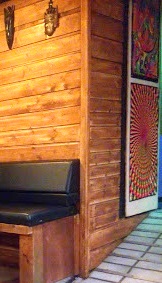
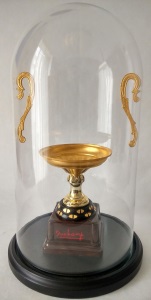
In 1996, he decided to go and discover his father's country : after a few weeks, he found a job as a handyman at the « De Graal » coffee shop in Amsterdam (Netherlands). [3]
A few months later, the owner asked him to become manager. He accepted and, as he launched new events which met with great success, he took the opportunity to permanently exhibit and sell his psychedelic paintings.
In 2002, he found himself on Piazza Navona in Rome (Italy), where he sold small watercolors of Italian landscapes to tourists, which he signs « David di Roma » produced before their eyes. [4]
In July 2008, he shared a booth with several artists at the « Tomorrowland » festival in Boom (Belgium), where he sold his « Impermanent Heterogeneous Objects » : assemblies of metallic objects varnished with transparent colored paint and placed under a bell, signed « D. de Jong ».
He spent the winter of 2012 in the Canary Islands, where he was hired at the restaurant « El Gran Dali » in Playa del Inglés as a tout and used this job to sell tourists small pencil drawings, made quickly on demand , which he signed in tribute : « El Gran David ».
Then in 2014 he left to explore Eastern Europe, and after a passage in the Balkans, he ended up settling in Bucharest (Romania), where he attempted to create a graphic design company for the web.
In 2015, he returned to Spain and lived in Catalonia, a region he is particularly fond of.
The owner of the Cannabis-Social-Club « La Rambla » in Barcelona asked him to decorate the walls with abstract paintings. He created ten canvases which he sold to customers, signed « D! ».
In the summer of 2016, the moving truck that was transporting his things from Bucharest swerved. Ending up in a ditch, it burst into flames and destroyed all of his artistic endeavors.
It will take him years to recreate these artworks, but this time they will be signed under his final artist's name : « Duchamp ».
He then decided in 2017 to transform what had been a dilettante occupation into a professional career as a contemporary artist; to which he will devote the rest of his life.
Absent from France for thirty years, he returned to the Côte d'Azur in 2018, presenting a major piece, « Artwork # Zero » and two paintings from his collection « I do not agree ! » at « Le César » gallery held by Ben Vautier.
He launched his gallery on the web in 2019, where he exhibits his productions.
That same year, in December, he created the artwork « Fugue in G Major » [5] specially for the charity gala organized by the city at the opera of Nice, for the benefit of Lenval Hospital Foundation and the youth of the O.G.C.N [6], which was exhibited and sold by the auctioneer of the auction house « Millon Drouot ».
Note that it was the president of the O.G.C.N himself who bought this painting ! [7]
In 2020, was his performance: « Dictatorship : 3 days of silence » [8], sold to the artist « Ben Vautier » in whose home it is currently exhibited.
Exhibitions & Events
- 2023 - 2024 : « Urinal » exhibited at the International Museum of Naive Art (France) for 1 year !
- 2022 (Nov.) : Conference on Crazy Artists - MAMAC (Museum of Modern Art and Contemporary Art), Nice (France)
- 2022 (Oct.) : Personal exhibition - Gallery « L' Entrepot », (Monaco)
- 2022 (Sep.) : Show on my artist's life - Theater « L'EAU VIVE », Nice (France)
- 2020 : « Dictatorship » - House of Ben Vautier (France) - permanent exhibition
- 2019 : « Fugue in G major » - Opera of Nice (France) - permanent exhibition at O.G.C.N headquarter
- 2018 : Artworks exhibited - Gallery « Le César », (France)
- 2015 : Abstract paintings - C.S.C « La Rambla », Barcelona (Spain)
- 2012 : Pencil drawings - restaurant « El Gran Dali », Playa del Inglés (Canary Islands)
- 2008 : « Impermanent Heterogeneous Objects » - festival « Tomorrowland », Boom (Belgium)
- 2002 : Italian landscapes (watercolors) - Piazza Navona, Rome (Italy)
- 1996 : Psychedelic paintings - coffee shop « De Graal », Amsterdam (Netherlands)
Photo Gallery (click on it !)
( Biography written by Thierry, his childhood friend )
Notes and references
1. Between 1954 and 1989, the autocratic regime of Todor Zhivkov brought about an era of political and social stability, and commercial openness to Western Europe.
2. David would never know his paternal grandparents, who were shot in September 1944, during the « Market Garden » operation, for having hosted English paratroopers.
3. The coffee-shop « De Graal » : www.amsterdam.info/coffeeshops/de-graal
4. In reality, these watercolors were made by his friend Manolo, but since David was a better seller, he had found this trick of signing them in front of the customers.
5. You can see this artwork on my website by clicking here.
6. They support the Endowment Fund : www.ogcnice.com/fr/citoyen/ils-nous-soutiennent
7. Results of the charity gala : www.ogcnice.com/fr/actualite/38722/130-000-pour-les-enfants
8. You can see this artwork on my website by clicking here.
